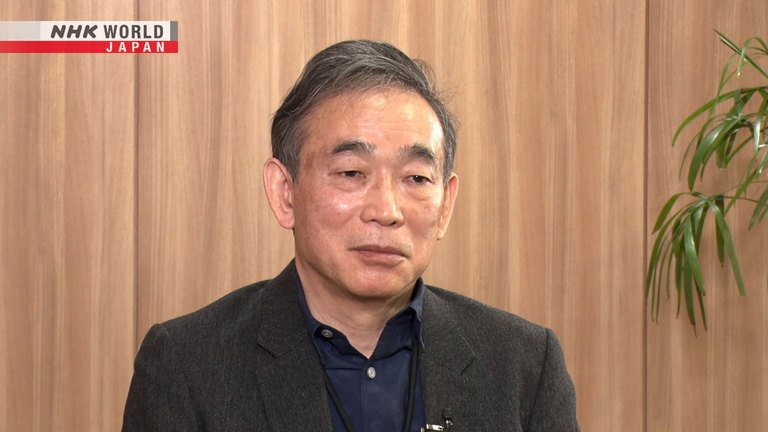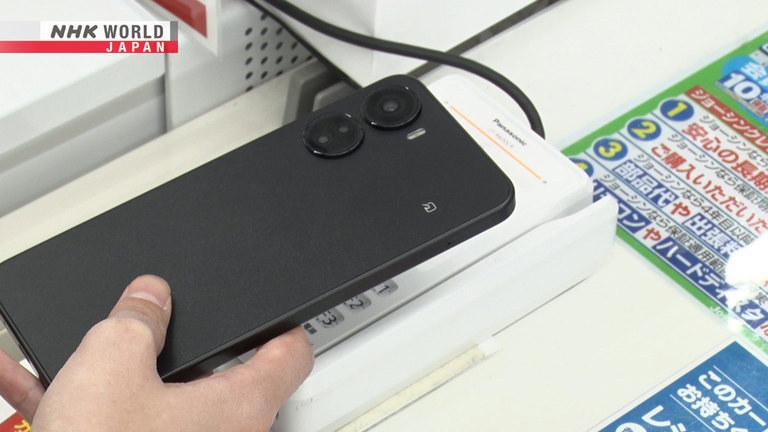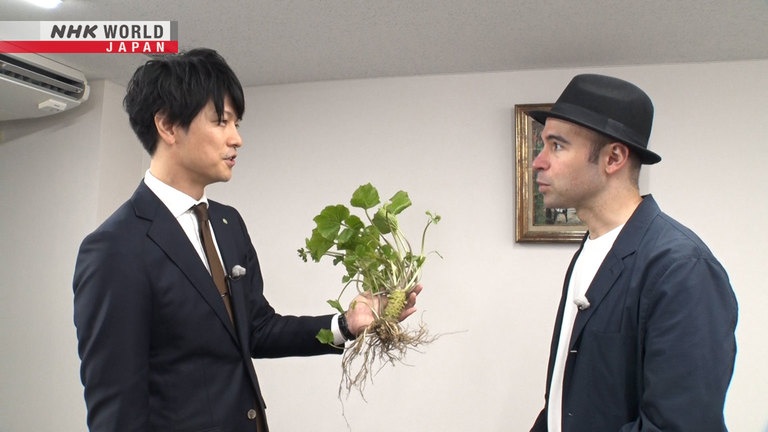Contactless IC Cards / Wasabi Packets
The stories behind hit Japanese products, plus top creations for niche markets. This time: contactless IC cards & wasabi packets.



Transcript
"Japan's Top Inventions"
The behind-the-scenes tales of hit products and creations from Japan.
This is "Japan's Top Inventions."
On today's show, cards which work with a simple wave.
How do they work?
We share the story of their invention.
Later, a factory which makes something important to sushi.
But what's with all the white smoke?
Stay tuned to find out.
Hello, welcome to "Japan's Top Inventions."
I'm your host, Jason Danielson.
In the first half of the show, we take you "Behind the Creation."
Today's topic is this.
Contactless IC cards.
These cards contain a coil and an integrated circuit, or IC chip.
Hold the card over a reader, and in a tenth of a second,
the data on the chip is wirelessly transmitted.
In Japan, contactless IC cards are used to board trains and buses.
They're also used for company security gates.
Development was challenging, and spanned a decade.
A major electronics retailer in Tokyo.
Over in the smartphone section
are devices made by companies around the world.
Many of the phones have this symbol on them.
This means that the phone works with contactless IC technology.
Just hold it over a reader...
and you can make a cashless payment.
After adding your credit card to the phone,
you can use the contactless payment function.
This feature has proven to be popular with users of all ages.
Our story begins back in 1987.
Japan's economy was booming like never before.
One area which was growing quickly was parcel delivery services.
Distribution centers were filled with packages.
One day, a request came to the research lab
of a major electronics manufacturer.
The client was a major delivery company.
They were wondering if there was some way
to automate the sorting of parcels.
Engineer Kusakabe Susumu was involved with development at the time.
Here's how he remembers things.
Packages coming down the conveyor belt needed to be sorted by destination.
Figuring out how that would be decided
was something which offered a considerable challenge.
The development team quickly began evaluating the problem.
The concept they came up with
was wireless IC tags.
Until then, workers had to check the destinations
and sort the packages by hand.
The team wanted to stick tags with the delivery address onto the package.
A reader would pick up the info wirelessly,
and the sorting process would be automated.
The team began making their own design for the key component,
the IC chips.
They created prototype IC cards,
and tested reading them.
Later though, a significant issue became apparent, manufacturing cost.
Kusakabe's prototype card had an IC chip, a coil, and a thin battery.
It cost up to 2,000 yen to make one.
That was way beyond what the client wanted.
To put it roughly, the client was hoping it would cost less than 20 yen.
So at that point it was 100 times more than 20 yen.
That wasn't going to work.
The development team decided to give up on the product.
However, Kusakabe wanted to search for a new client,
and he continued developing the IC cards.
Then one day, some news reached Kusakabe.
The railway was developing a new automatic ticket gate.
Kusakabe immediately reached out to the railway company for a visit.
With his IC card in hand,
he did his best to convince the company.
"This card has a built-in chip.
You can use it instead of a ticket.
Just wave it over the ticket gate."
The representatives from the company were impressed.
They agreed to jointly develop the technology on the spot.
The team also had their eyes on another use case,
office buildings.
With the Japanese economy booming at the time,
new office buildings were going up all over the greater Tokyo Area.
There was demand for new systems which could control entry to the buildings.
The company had plans for a system which would use their IC cards.
For example, you could be wearing the IC card on your chest.
The system would recognize your ID and automatically open the doors.
The team brought this concept to the building managers.
In January of 1990,
a major gas company decided to use the system.
After, many other companies also decided to adopt it.
The developers were taking technology intended to help with deliveries,
and adapting it for office buildings and railways.
While development appeared to be going smoothly,
the team soon faced some unexpected challenges.
The IC cards were being jointly developed with the railway company.
One day, the client brought up a challenging request.
Was it possible for one person to pass through each second?
60 people every minute?
It was a tough proposition,
but if their technology got adopted for the ticket gates,
it would be great business.
In order to reduce the processing time as much as possible,
Kusakabe redesigned the chip circuitry.
He worked tirelessly over many long days.
But then one day,
a fellow developer rushed in with bad news.
"The railway company has decided to use a different card system."
The company had gone with an existing magnetic system.
It would track the balance on a prepaid card.
You had to insert the card into the gate for it to let you through.
And, there was another setback which caught the team off-guard.
This time, it was the office building entry system.
It seemed they were getting many reports of malfunctions.
The issue was with the number of new buildings going up.
The buildings were so densely packed
that readers from neighboring buildings were interfering with each another.
There was no way to eliminate the interference.
The team decided they would have to withdraw from the market.
Half a year later. December 1992.
An unexpected opportunity presented itself to Kusakabe.
The subway in Hong Kong was looking for an automatic ticket gate system.
The development team flew into Hong Kong
and entered their bid for the system.
As they presented their IC card technology,
the other side made a request.
"Can you get rid of the battery?"
It wouldn't be good if the card ran out of power and stopped working.
With a 2-year battery, you'd have to dispose of the card after 2 years.
That's one more thing to deal with.
The Hong Kong client wanted something semi-permanent, with no battery.
How would the chip function without a battery to power it?
Kusakabe started investigating.
He came across a certain idea.
Electromagnetic induction,
something he'd learned about in science class.
When a magnet is moved near a coil,
an electric current is generated.
Using the same principle,
the ticket gate would emit faint electromagnetic waves
which would induce a current in the card's coil.
A custom rig was created, and testing started over from scratch.
Simply put, I just had to get it done.
That was the situation I was in.
It was pretty obvious how bad it would be
if I couldn't do it and just gave up.
Kusakabe continued to tune the strength
of the electromagnetic waves and improve the IC chip.
However, the reader struggled to pick up the card.
Moving it further or closer didn't seem to help.
Kusakabe often found himself working overnight without going home.
Then one day, as Kusakabe continued experimenting,
he brought an improved card within 10 centimeters of the reader.
It worked.
He tried it again, and again.
The reader picked it up each time.
And so, the contactless IC card was complete.
In September of 1997,
the cards were implemented in Hong Kong's mass transit system.
Some time after, a certain Japanese family landed in Hong Kong.
It was Kusakabe, who had worked through his holidays,
this time on vacation with his family.
One of their first stops?
The subway ticket gates.
I was rarely home.
My family members had no idea what I was doing.
We went to the Hong Kong subway
and saw people scanning the cards without taking them out of their bags.
It was fascinating seeing the ways the cards were being used.
That was the first time my family members understood what my work was.
That was the happiest thing for me.
Afterwards, the contactless IC cards
came to be used in India, Singapore,
Thailand, and China.
They became a convenient tool for many people using transit.
Later, contactless IC technology found its way into smartphones,
and is now used for cashless payments.
How do experts view this invention?
We're joined by Inoue Sozo to learn more.
Welcome to the show!
Thank you.
Contactless IC cards were first used in Hong Kong.
What's your opinion of this invention?
The cards are easy to use.
Just a simple tap will do.
The coil inside picks up waves from a distance,
makes electricity flow, and that allows the card to be read.
If this cost a lot of money to make, it would be meaningless,
but it's made at a very low cost.
And if it broke easily, that would also be bad,
so they're built to keep working even with heavy use.
I think it's groundbreaking how convenient they are
and how quickly they work.
Early in development, the card readers caused interference with each other.
How was this issue solved?
With wireless technology,
there's the issue of waves being sent out too far.
That's a problem.
You have to find a frequency range which works well at short distances,
something like 10 centimeters,
and make adjustments
so that the wireless communication works at that kind of range.
Lately, smartwatches and other small smart devices
have the same technology,
so you can tap to do shopping or pass through ticket gates.
These kinds of things have become possible.
How do you see contactless IC card technology evolving in the future?
I can see the technology being used for more applications.
For example, on cargo ships which can't connect to a network,
or for tracking wild animals,
or for use in outer space.
It can be used in places where it's difficult to get electricity.
Along with things like image recognition,
technologies like these can work in conjunction
and continue to improve.
Thank you for your time. Great speaking with you.
Thank you very much.
Top Niche Creations.
Our next segment is "Top Niche Creations."
Today we're looking at this,
sushi platters, sold around the world.
Included with these platters is a little something you can't forget.
A company in Japan is said to be the first to make them.
Just what is this item? We sent our reporter to learn more.
Hey everyone, Cyrus Nozomu Sethna here.
Today I am coming at you from Aichi Prefecture.
The company we're visiting is right over here.
Come and join me!
I'm here at a food processing company in Nagoya City, Aichi Prefecture.
Hello, good afternoon.
Hi. Welcome.
Showing me around today is Miura Yosuke,
who works in product development.
Inside, I'm greeted with these.
"Nigiri" sushi,
rolls,
and "chirashi."
Now, what goes with all of these?
So what is it that you make here?
Actually, we make something found in these platters,
wasabi packets. We make these.
Ah, I see.
Ever since sushi was invented in the Edo period,
it's been eaten with wasabi.
This company has been making wasabi packets for over 50 years.
They were the first in the industry.
What prompted you to make wasabi packets?
Supermarkets which sell sushi like this
used to include wasabi by hand,
but it was a lot of work.
Because of that, our company was asked whether wasabi packets could be made,
and that's how we began development.
The company produces more than just wasabi packets.
This is a powdered wasabi that you mix with water.
This is a chopped variety which has a bit of crunch.
And their premium offering
is this wasabi.
We were given a look at the contents.
Wow, that's a very natural green.
Yes, this has no artificial coloring.
That's the green of real wasabi.
I have a taste test.
That's interesting. It's actually not that spicy,
or rather, it comes out gradually.
That's right. It's not super spicy.
It's a natural level of heat and sweetness,
with a fresh and pleasing aroma.
You can taste the difference.
Rather than that burn in your nose, you feel this freshness.
The main ingredient for this can only grow in very clean water.
Wasabi plants, raised in Japan.
When you grate the rhizome of the plant, you get wasabi.
But its flavor and spiciness are delicate.
After being exposed to air for about 3 minutes, they begin to decline.
That's why the company developed this,
a special method of preserving the flavor and spiciness of real wasabi.
At the factory, there's some kind of white smoke coming out of the vessel.
The wasabi is being frozen at ultra-low temperatures.
We were given a special look at what they use to freeze the wasabi.
Liquid nitrogen, at minus 196 degrees Celsius.
That's extreme!
Don't want to be putting my hands in there.
Definitely not.
The wasabi root is placed in here.
What exactly happens to it?
I was given a demonstration.
Here we go.
That's quite the reaction!
It splashes.
That's something. Why is it coming out like that?
It's basically boiling.
We put something that's room temperature into minus 196 degrees,
so it's similar to when you boil water.
That's really neat.
About 30 seconds later...
That should be good.
It's become very white.
Completely frozen, huh?
Yes. You can see all the cold vapor.
How frozen is it?
We gave it a hit with a hammer.
All right. 3, 2, 1.
Yes, I see.
It wouldn't do this at all if you smashed it at room temperature,
but it's become so brittle that hitting it makes it shatter like this.
During manufacturing, frozen wasabi is similarly crushed.
You can hear this sound from within the vessel.
And here is the result.
The wasabi has become a fine powder.
It's packaged while frozen,
so that when it's time to be used, you melt it,
and get the same heat and flavor of freshly grated wasabi.
So where is this product used?
So this wasabi is served at places like high-end restaurants
which really care about the taste of the wasabi.
We've paid special care to make sure that the spiciness and flavor
of real wasabi is preserved in the final product.
I see.
The company is a leading manufacturer of wasabi for professional use.
It was founded in 1929.
The company started off as a wholesaler of wasabi.
It grew its domestic market share
by developing products like wasabi tubes,
powdered wasabi, and wasabi packets.
As Japanese restaurants became more common around the world,
the company expanded their efforts overseas.
Currently, their wasabi products
are sold in over 70 countries and regions.
And now, they're putting effort into new products
which make use of wasabi.
This bottle actually contains a skin toner which utilizes wasabi extract.
I never knew that wasabi was good for your skin.
So the spiciness doesn't burn or anything?
We've removed the spiciness. It's totally mild.
Give it a try.
The liquid is clear and colorless.
Oh, it smells quite nice.
Yes. It's not the spicy wasabi you know.
It's nice and light when applied.
You're right, it's not heavy at all.
How did you get the idea to use wasabi for skincare?
Well, we were inspired because wasabi farmers tend to have good skin.
We researched the compounds in wasabi and tested their effects on cells.
We found something that increases collagen.
The company has long been researching wasabi compounds.
They discovered something found in the leaves called isosaponarin.
It's said to support the production of collagen in the skin.
Also, there's a compound called hexaraphane in the rhizome
which is said to improve memory function.
They've developed a supplement which contains this compound.
I'm amazed that wasabi was hiding all these secrets.
Yes. In the past, wasabi was cultivated as a medicinal plant,
so we consider it a health food.
It's not just spicy. It also has health and cosmetic benefits.
We want to showcase these other facets to the world.
Time for a pop quiz!
The wasabi manufacturer made large strides
in markets around the world.
Apart from sushi, they also suggested
that wasabi be used with a certain meat dish.
What could it be?
The answer is... steak!
The company suggested wasabi as a condiment for steaks.
The spiciness of the wasabi helps balance out the richness of the beef.
Sushi and steak! I wonder what else wasabi goes well with.
That's all for this episode of "Japan's Top Inventions."
We'll leave you with more about the contactless IC cards
from the first half of the show.
See you next time! And Stay Inventive.
(Contactless IC cards were invented some 30 years ago.)
(Now, the tech is used in smartphones for transit and cashless payments.)
(Over 1.5 billion of these IC chips have shipped around the world.)
(Kusakabe Susumu was involved with developing the IC cards.)
(He still treasures this prototype IC card.)
(It all started here.)
It's like a child to me.
So many people use the technology without thinking about it now
as a part of daily life.
To think it started with this,
it truly is a precious memory for me.